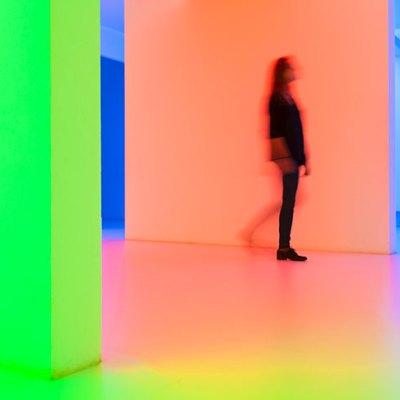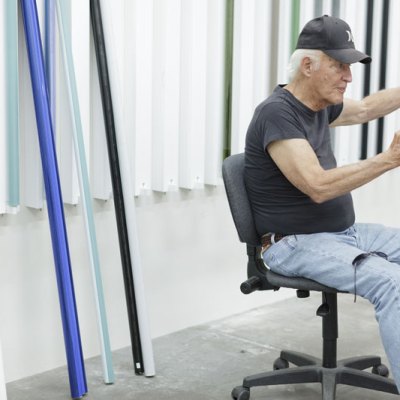Housed in a former factory for precision instruments, Geneva’s museum for modern and contemporary art, MAMCO, is accessed through a nondescript side alley that greatly belies the building’s size so that, once inside, its interior gives the impression of expanding in impossible directions. A government-owned institution since 1994, the museum was first conceived in the 1970s as a small, independent collection assembled by the Association pour une musée d’art moderne. Early exhibitions mimicked artist’s studios and there was no obvious partitioning between temporary installations and permanent works. With a collection of some 3,000 works, the museum carries this makeshift spirit into the 21st century by relying on a continuous stream of loans and substantial thrice-yearly rehangs.
MAMCO may have achieved the holy grail to which many better-known contemporary art institutions now aspire: acting as a hub for the local community of artists. Over the course of a single opening, I am introduced to a who’s-who of Geneva’s art scene. As I am taken through the permanent galleries, MAMCO takes on the faintly absurd atmosphere of a jungle gym. The accompanying text for Sylvie Fleury’s Be Good! Be Bad! Just Be! (2008), an unexpectedly deep and dark grotto, promises ‘the ultimate return to the womb’. Once I am reborn into the gallery’s dizzyingly bright lights, I find myself walking around in circles as I push through the labyrinth of doors to nowhere in a 1985 replica of Gordon Matta-Clark’s Open House (1972), an installation in New York’s SoHo that used building parts from demolition sites to divide a dumpster into tiny compartments.
Earlier in the day I meet MAMCO’s director Lionel Bovier, a smartly dressed, unfazed man whose manner adds some context to the museum’s eccentricities. The first sign of him in his office is the stream of smoke from a heavy, cut-glass ashtray and, illuminated by the pale morning sun, he sits poised between cigarette and espresso cup as he explains what he believes to be a museum’s higher purpose – to create new narratives about the history of modern art.
Installation view of ‘Arnulf Rainer: Territoires latents’ at MAMCO, Geneva. Photo: Annik Wetter; courtesy MAMCO Geneva

This experimental approach is well exemplified by the current showing of four artists who have remained at the fringes of the minimalist movement. Rather than a side-by-side comparison of the artists, each has been granted their own simultaneous solo show with a set of unrelated curators and contexts. The presentation dedicated to Irma Blank (b. 1934), for example, is, in fact, the second iteration of a travelling show. Arnulf Rainer (b. 1929) receives a comparatively small, two-room ‘ensemble’, seemingly tacked on later to reveal the spoils of a new donation from the late gallerist Michel Foëx.
None of the artists ever met each other and they share no obvious historical association but Bovier, who is more interested in how their work represented a new ‘typology of pictorial gestures and signs’, has successfully shown that there are insightful formal comparisons to be made. Martin Barré (1924–93), the least well-known of the four, receives his first retrospective since 1988. His spray-can series from the 1960s contains scattered markings, their light touch and diffused edges acting as fleeting inscriptions of gesture through time and space.
Barré’s playful, self-referential interrogations of figure and ground ran radically against the grain in his native France, and MAMCO cleverly weaves the exhibition around its permanently installed reconstruction of the apartment of French collector Ghislain Mollet-Viéville. Containing works by Carl Andre, Sol LeWitt and Donald Judd, it was probably Barré’s first opportunity to see minimalist art in Paris. Still, Barré’s preoccupation with painting differentiates him from his American counterparts. To Judd, with his specific objects, the works would have been illusionistic and lamentably European.
The work of Irma Blank presents more of a challenge to established notions of what art can be. She left Germany as a young woman to follow her husband to Sicily and her sense of isolation and displacement was expressed in the simultaneously meaningless and universal language of the Eigenschriften (Self-Writings) series. In the years that followed, her style shifted from hastily scribbled texts to markings more like frequency waves, and she began making audio recordings of the act of drawing. The dense layering of an eight-letter alphabet to produce a mass of fuzzy, vibrating lines in Global Writings (2000–2016) echoes the obsessive repetition used by many artists associated with minimalism. A room just around the corner holds Arnulf Rainer’s etched prints, which he produced using plates feverishly overworked to the point of obliteration.
Installation view of ‘Rosemarie Castoro’ at MAMCO Geneva. Photo: Annik Wetter; courtesy MAMCO Geneva

The only American, Rosemarie Castoro (1939–2015) occupied a loft in New York and her floor is filled with evidence of her relationships with Andre, LeWitt and Agnes Martin and an abundance of her visual poems, journal entries and postcards. The viewer is quickly moved on from her bland, early ventures into geometric abstraction towards her conceptual, post-minimal practice, which is the highlight of all four shows combined. Room Revelation (1970) was first installed at Vancouver Art Gallery, but, given its high voltage and small capacity, it would be deeply impractical to recreate in any museum with more footfall. As a group of visitors stand in the dark room waiting for a central bulb to slowly dim, they are left with little else to think about than the passage of time and their body in space.
Not long afterwards Castoro produced gothic, animalistic works reminiscent of Louise Bourgeois, and you can sense the delight with which she foresaw how Land of Lashes (1976), a line of small, disembodied eyelashes scuttling along like spiders, would unnerve the viewer. A little further along in the circular gallery space, I am confronted by the maze of 8 Corners (1971). At every turn her installations grow larger and more surreal, yet at MAMCO they feel comfortably at home.
‘Martin Barré’, ‘Rosemarie Castoro’, ‘Irma Blank’ and ‘Arnulf Rainer: Territoire Latents’ are at MAMCO in Geneva until 20 February 2020.


